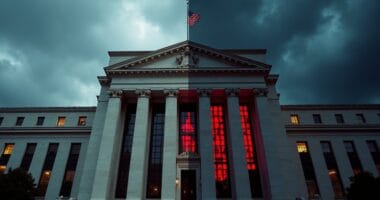The Fed’s worst nightmare is materializing: a massive $1.7 trillion shadow credit system operating beyond its reach. Traditional monetary policy tools are becoming useless as private lenders, peer-to-peer networks, and unregulated credit markets expand rapidly. With 26 million Americans living in credit invisibility, the Fed is fundamentally flying blind. Risk assessment? Good luck. The potential for financial shocks spreads like wildfire through this parallel universe – and that’s just the beginning of their problems.

Uncertainty looms large at the Federal Reserve as invisible credit growth threatens to upend traditional monetary policy. With a staggering 26 million Americans living in credit invisibility, the Fed’s grip on financial reality is slipping through its fingers like sand. It’s a mess of unreported transactions, hidden debts, and lending arrangements that dodge the official radar.
Hidden credit networks are expanding in America’s shadows, leaving the Fed to navigate economic waters with an increasingly unreliable compass.
The problem? A shadow world of credit is expanding right under the Fed’s nose. Private credit funds, peer-to-peer lenders, and that cousin who keeps lending money to everyone in the family – they’re all part of this invisible web. And none of them bothers reporting to credit bureaus. Great for privacy, terrible for economic oversight. The market has exploded to nearly $1.7 trillion in size, rivaling traditional leveraged loans and high-yield bonds.
The Fed’s traditional tools are becoming about as useful as a chocolate teapot. How can they set effective interest rates when they can’t see half the credit market? Non-bank lenders are having a field day, operating with fewer disclosure requirements than your average food truck. Meanwhile, private credit markets are growing faster than a teenager’s appetite.
The risks are real and growing. When financial shocks hit, these interconnected non-bank lenders could spread problems faster than gossip at a small-town diner. Unregulated credit growth is like a pressure cooker without a safety valve – nobody knows when it might blow.
It’s not just about policy wonks wringing their hands. This invisible credit system is creating a parallel financial universe where risk assessment is about as standardized as fingerprints. Community lending, rent-to-own deals, and payday loans slip through the cracks of official statistics like ghosts through walls.
The Fed’s challenge is clear: they’re trying to steer the economy while flying partially blind. Without accurate credit data, their policy decisions could be as effective as using a weather app from last week. The explosive growth of untracked lending isn’t just a statistical headache – it’s a potential powder keg in the financial system. And nobody knows just how big the blast radius might be.





